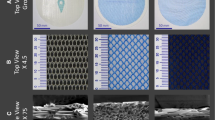Abstracts
Background: Many prosthetic materials are used in incisional hernia repair, including polypropylene (PP) and expanded polytetrafluoroethylene (ePTFE). However, PP forms severe adhesions and ePTFE has raised concerns about the adequacy of tissue attachment. Methods: The early tissue attachment strength of PP and two new forms of ePTFE (DLM and DLMC) was compared in a rabbit model (n = 12) in which disks of the three meshes (n = 8 of each material) were implanted against the abdominal wall for 3 days. Results: Tensiometer testing found that DLMC mesh had significantly greater attachment strength than PP (p = 0.02). Histologic studies indicated that this was due to cellular ingrowth. Tissue adhesions were observed with all eight PP disks, one DLMC disk, and none of the DLM disks. Conclusion: Modified forms of ePTFE mesh may provide abdominal wall repairs that are as strong or stronger than those obtained with PP, with early tissue attachment and without adhesions.
Similar content being viewed by others
Author information
Authors and Affiliations
Rights and permissions
About this article
Cite this article
LeBlanc, K., Bellanger, D., Rhynes, K. et al. Tissue attachment strength of prosthetic meshes used in ventral and incisional hernia repair . Surg Endosc 16, 1542–1546 (2002). https://doi.org/10.1007/s00464-001-8271-y
Received:
Accepted:
Published:
Issue Date:
DOI: https://doi.org/10.1007/s00464-001-8271-y




